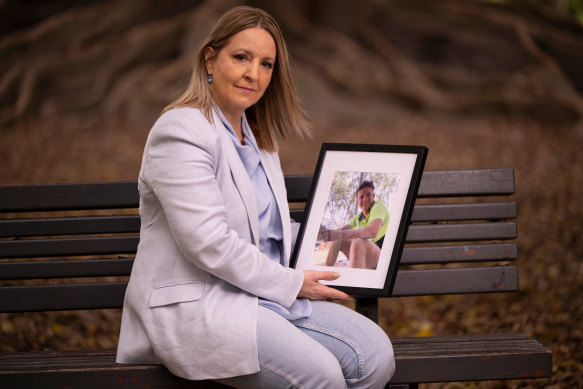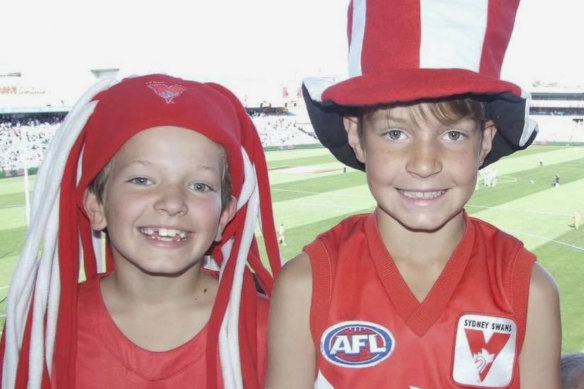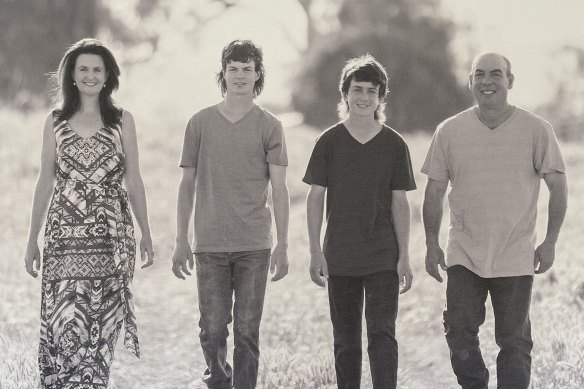- Exclusive
- National
- Concussion crisis
Antonio loved the Swans. A little-known condition killed him on the football field
By Riley Walter
The first time Wendy Smith heard about a little-known condition called second impact syndrome while researching her youngest son’s concussion symptoms, she thought nothing of it.
When she heard about it again six years later, her oldest son, Antonio Lo Iacono, had just died from a head injury suffered during an Australian rules football match in country South Australia.

Wendy Smith, whose son Antonio Lo Iacono died from a head injury during a football match in South Australia, wants a coronial inquest into his death.Credit: Ben Searcy
A talented junior footballer with no underlying health issues, Antonio’s death came from nowhere and with no answers.
“It didn’t make sense to me that a 20-year-old, fit, young man dies,” Smith told this masthead.
“That shouldn’t happen on a footy field.”
Then the penny dropped.
Antonio was one of several young athletes globally suspected of dying since the early 2000s from second impact syndrome, which occurs when someone suffers a second head impact before properly recovering from an earlier one, causing the brain to catastrophically swell. In some cases, the fatal blow can come days or weeks after the first impact.
For Antonio, who was born in Sydney and grew up a diehard Swans fan, the two hits were less than a half of football apart. First, a high, heavy hit in the first quarter grounded him before a second, innocuous hit to his head in the third quarter left him unconscious and instantly brain-dead on April 23 last year. A month earlier, he was concussed during a pre-season trial match.
Dr Adrian Cohen, a former senior lecturer at the University of Sydney and a traumatic brain injury expert, believes Antonio is one of at least 21 young athletes who have died from second impact syndrome since 2006, including five footballers in Australia in the past eight years.
But despite the similarities in the cases and the repeated efforts of medical experts to raise awareness, the syndrome is yet to be identified as an official cause of death. Often, spinal injury or cardiac arrest are common focuses of autopsies when a young person dies suddenly without explanation on a sporting field, rather than second impact syndrome.

Antonio Lo Iacono, right, pictured with his younger brother, Jack, died after a head injury suffered during an Australian rules football match in South Australia.
“You only find that if you go further than just doing an external scan,” Cohen said. “If you don’t look, you don’t find.”
Cohen’s views are shared by retired neurosurgeon and clinical professor at the University of Sydney, Michael Besser, who said signs of second impact syndrome were not often visible in an autopsy without knowing what to look for.
“People just don’t know about it,” Besser said. “If they come to autopsy, there’s unfortunately little to show.”
Antonio’s autopsy found his brain was more swollen than what would be expected from a hypoxic brain injury, an injury caused by the brain being starved of oxygen as a result of cardiac arrest, and raised the possibility of second impact syndrome being a factor in his death. Despite that, the official cause remains under review.
“My recommendation would be any time you get what is always a tragic death on a sporting field, or where there has been trauma associated with the death, that instead of just looking at the heart, the spine and for a bleed around the brain, you actually examine the tissue for second impact syndrome,” Cohen said.
Professor Alan Pearce, the research manager at the Australian Sports Brain Bank and an adjunct research fellow at Swinburne University of Technology, wants more funding to support research into second impact syndrome, and for coroners to be more open to exploring the condition during inquests.

Lui Polimeni was 15 when he died from a head injury suffered during a junior rugby league match.
Pearce, one of the country’s foremost concussion experts, said one of the greatest difficulties in establishing second impact syndrome as a possible cause of death was retrospectively identifying the first impact athletes had suffered, and when, in the lead-up to their death.
“The issue is trying to properly identify that first hit,” Pearce said.
“In cases around the world, the individual had the second impact in the week or weeks after.”
Lui Polimeni was 15 when he died from a head injury suffered during a junior rugby league match in Gundagai in 2016. But it wasn’t until after his death that his parents, Jenny and Gino Polimeni, became aware he went into his final match with a headache bad enough he asked the club’s trainer for Panadol.
“He didn’t tell us. We had no idea,” Jenny said.
By the time he died, Lui had saved enough for a house deposit, was raising his own piglets and cattle, servicing trucks every Saturday morning and waking up at 3am to help out in the family fruit and veg store. Like Antonio, Lui was also a gifted athlete with no underlying health issues.
And with no thorough examination of Lui’s brain, his parents were left in the dark about how they lost their son. What they were told was that his head injury was so severe it resembled that of a fatal car crash victim.
“I just remember thinking, how can that be? I just don’t understand at all,” his mother said. “I just can’t believe ... such a fit, healthy, hardworking young man that [this] can happen to.”
Then Jenny started to connect the dots when she read about second impact syndrome.
“I thought, well, Lui, we found out later, had the headache. He could have had a hit at footy training, he could have had a hit at footy the week before, he often rode his motorbike, he could have come off that, he could have been rumbling around at school. We just don’t know what the prior incident was, but we do believe that’s what it was, second impact syndrome,” she said.
The dangers of head injuries in junior football have again been thrust into the spotlight this week after revelations Manly Sea Eagles rookie Keith Titmuss, 20, was suffering from chronic traumatic encephalopathy (CTE) when he died from heat stroke in 2020.
At an inquest into the 2016 death of Murwillumbah footballer Grant Cook on the NSW North Coast, Besser identified second impact syndrome as a possible factor in the tragedy.
The 28-year-old father of two died at Gold Coast University Hospital on September 12 after suffering a head injury during a tackle in the first half of the Mustangs’ semi-final against Casino.
In his 2020 findings, Deputy State Coroner Derek Lee recommended that the NSW Rugby League (NSWRL) develop education and training programs highlighting the importance of detecting head injuries, how they can occur, and the risk of second impact syndrome.
An NSWRL spokesman said those recommendations had been implemented “within the wider context of adherence to national guidelines regarding concussion”.
Earlier this year, the Australian Institute of Sport released a series of guidelines, which have been largely adopted by sporting codes across the country, including that grassroots players be sidelined for a minimum 21 days after suffering a concussion.

Jenny Polimeni with her sons, Lui and Joey, and husband, Gino.
Besser said the rest period was “at least a start” but believes a minimum four-week stand down should apply to all junior footballers who suffer a concussion.
“If it was a son of mine who was 18 and knocked out, I would say no more football for the rest of the season,” Besser said.
“There needs to be an awareness that if people are knocked down, they need to stay down and be assessed properly.
“These sorts of injuries occur every day, every game. One concussion you can recover from, but if you get a second one …”
Veteran AFL player agent Peter Jess has long advocated for a “concussion passport” in the form of a national register to track players who have suffered head injuries, as they change clubs or leagues, to ensure they can’t take the field without first being cleared by a doctor.
If such a register had been in place when Antonio transferred leagues at the beginning of the 2023 season, a concussion he suffered months earlier in a final may have been flagged.
“We’re seeing deaths in rugby, we’re seeing deaths in AFL and these are at a community level,” Jess said. “This is a community-based issue, it’s not just an elite issue.”
Smith wants a coronial inquest into her son’s death to determine what caused it, how it might have been prevented, if previous concussions played a part and to warn others about the dangers of second impact syndrome.
“That’s the only way I’ve got a chance of getting people to notice,” she said. “He didn’t die for nothing.”
The Polimenis have also been left in limbo for a decade without the closure of knowing exactly what killed their son.
“I wouldn’t say it’s ruined our lives but pretty close. It’s taken us to rock bottom and we’ve had to learn how to try to live again. It has been really tough,” Jenny said.
But like Wendy Smith, Lui’s mother hopes his legacy will help other families avoid what hers has gone through.
“He was an incredible young person,” she said.
Start the day with a summary of the day’s most important and interesting stories, analysis and insights. Sign up for our Morning Edition newsletter.